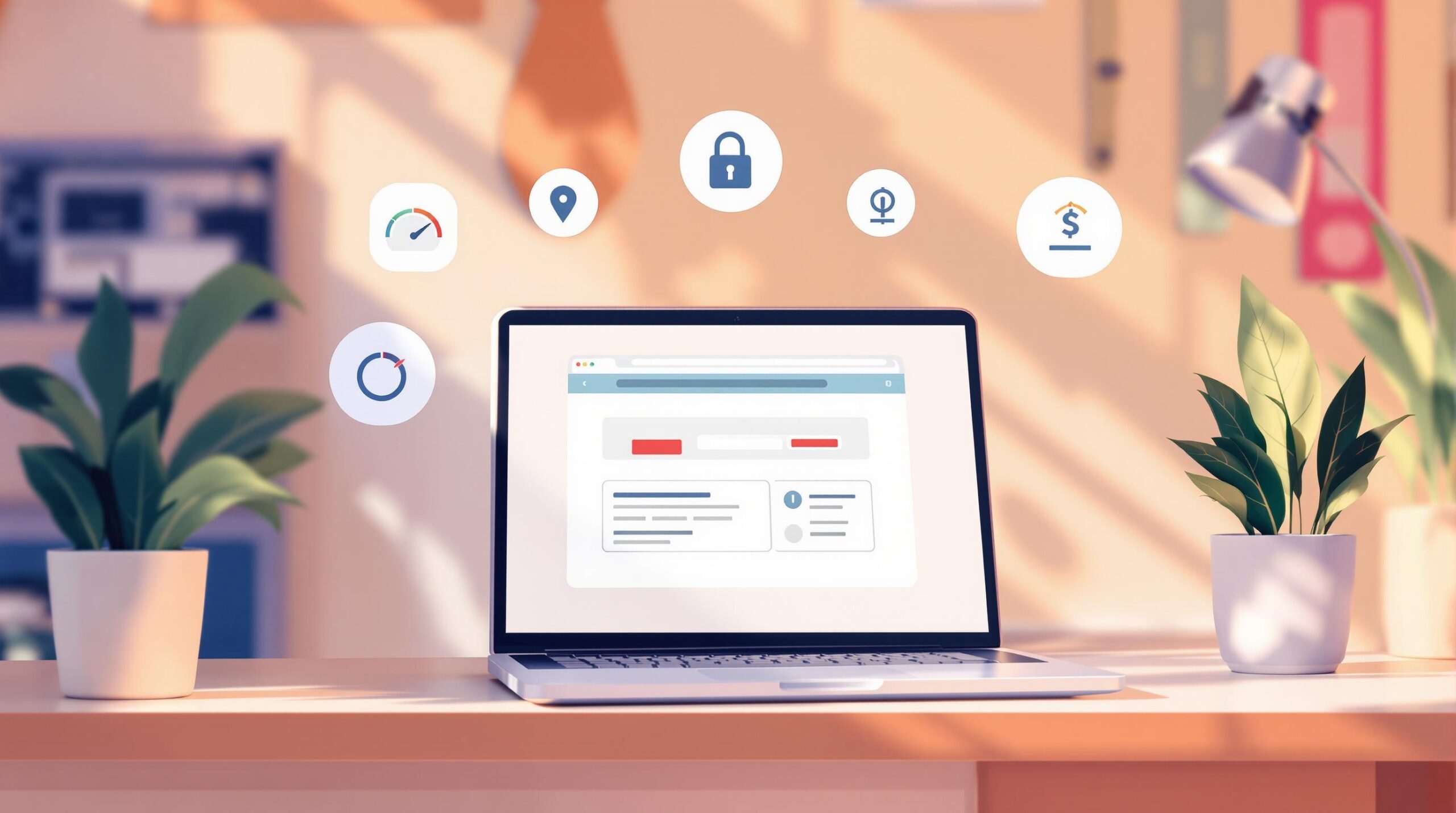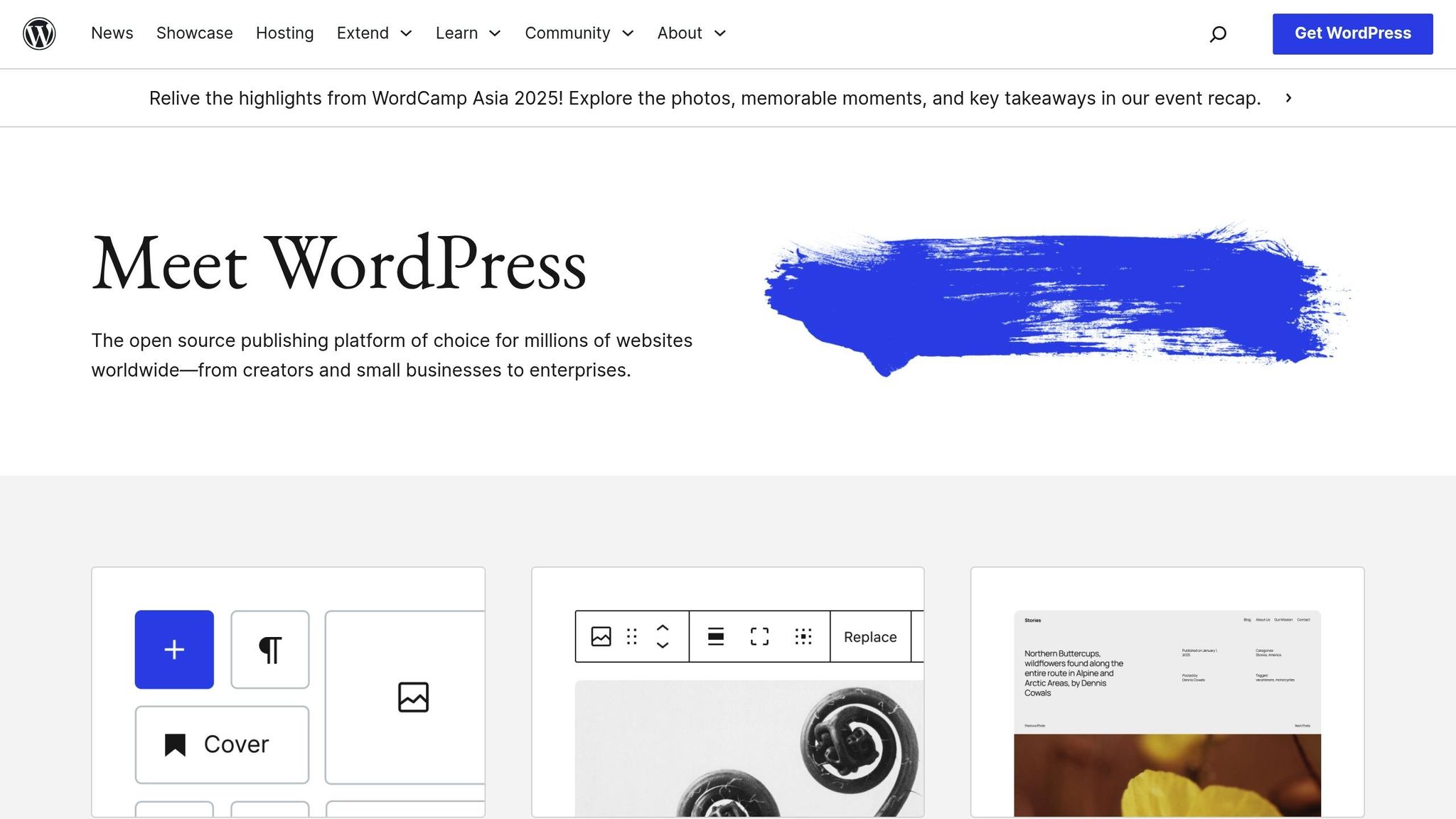5 Signs Your WordPress Site Needs Better Hosting

-
Slow Loading Times
- A 1-second delay in load time can reduce conversions by 7%.
- Causes: Limited resources, outdated servers, or distant server locations.
-
Frequent Downtime
- Excessive outages hurt user trust and SEO rankings.
- Compare your uptime to the industry standard: 99.9% uptime equals ~43 minutes of downtime per month.
-
Security Issues
- Frequent malware infections or outdated plugins make your site vulnerable.
- Look for hosting with advanced firewalls, real-time monitoring, and automated updates.
-
Traffic Overload
- Your site crashes or slows during traffic spikes.
- Solutions: Scalable hosting, CDNs, and load balancing.
-
Poor Support
- Long wait times or unhelpful support can leave you stranded during critical issues.
- Reliable hosting offers 24/7 expert support with fast response times.
Quick Overview
| Sign | Impact | Solution |
|---|---|---|
| Slow Loading Times | Hurts user experience and revenue | Upgrade to faster servers or use a CDN |
| Frequent Downtime | Damages trust and SEO rankings | Choose hosting with higher uptime guarantees |
| Security Issues | Exposes your site to cyberattacks | Opt for hosting with robust security features |
| Traffic Overload | Crashes during high traffic | Use scalable hosting and caching solutions |
| Poor Support | Delays in solving critical problems | Select hosting with 24/7 expert support |
If your site struggles with any of these issues, it’s time to consider better hosting to improve speed, security, and reliability.
WordPress Web Hosting – Performance Comparison …

1. Site Takes Too Long to Load
A slow-loading website can hurt both your user experience and your revenue. Research shows that every extra second of load time can lead to a 10% drop in users.
Check Your Loading Speed
To measure how fast (or slow) your site is, try these tools:
- Google PageSpeed Insights: Offers detailed metrics and tips to improve performance.
- GTmetrix: Provides in-depth speed analysis with waterfall charts.
- Pingdom Tools: Monitors real-time performance from different global locations.
One critical metric to monitor is server response time, which often highlights hosting-related problems. These insights can help you identify if hosting issues are slowing down your site.
Common Hosting Speed Issues
Here are three common hosting problems that can drag down WordPress site performance:
- Resource Limitations: On shared hosting, multiple websites compete for the same resources, leading to inconsistent and sluggish performance.
- Server Location: If your server is far from your audience (e.g., a New York-based audience accessing a Singapore server), delays are inevitable due to the increased distance.
- Outdated Infrastructure: Older hardware and poorly configured servers often struggle to keep up with the demands of modern WordPress sites.
"One of the most common reasons for a slow WordPress site is poor hosting service."
- Mihajlo Ivanovic, SEO and content expert at Flow Ninja
Real-World Results
The numbers don’t lie: Walmart experienced a 2% boost in conversions, and AutoAnything saw a 12-13% increase in sales after improving their load times.
Key Performance Factors to Review
Use this table to identify hosting-related performance issues:
| Performance Factor | Warning Sign | Impact on Site |
|---|---|---|
| Server Response Time | High TTFB | Slower initial page load |
| Resource Allocation | CPU/RAM frequently maxed out | Site slows during peak traffic |
| Geographic Location | High latency for users | Increased loading times |
2. Site Goes Down Often
Frequent outages are a red flag for hosting issues. While no site can achieve perfect uptime due to necessary maintenance, excessive downtime can seriously disrupt your operations.
Why Sites Go Offline
Knowing the difference between "normal" and "excessive" downtime is key. Here’s a breakdown of industry standards for uptime:
| Uptime Percentage | Monthly Downtime | Suitable For |
|---|---|---|
| 99.9% | 43 minutes | Standard business sites |
| 99.95% | 22 minutes | E-commerce sites |
| 99.99% | 4.5 minutes | Enterprise applications |
Common causes of outages include resource overload, hardware failures, poor infrastructure, or mismanaged maintenance. Notably, poor infrastructure is responsible for 43% of data center outages.
Now, let’s look at how downtime impacts your business.
How Downtime Hurts Your Business
The numbers speak for themselves: 79% of consumers won’t return after a bad outage, 44% will share their poor experience, and just a 1-second delay can reduce satisfaction by 16%.
"If your website is down for just a day then there is unlikely to be any negative impact on your search rankings. However, an extended period of downtime, stretching over a number of days and weeks, could result in your website losing search rankings for the simple fact that Google does not want to send a user to a website that is frequently offline." – Matt Cutts, Former Google Search Team Employee
Real-life examples underline the consequences. In January 2022, Coinbase aired a Super Bowl ad with a QR code that drew 20 million scans in a minute, crashing the site for an hour and leading to missed opportunities and reputation damage. Similarly, in 2017, Amazon’s S3 cloud service went down for several hours, costing businesses over $150 million in losses.
To keep your site reliable:
- Compare your uptime statistics to the industry benchmarks above.
- Use uptime monitoring tools, review your SLA, and check server logs for early signs of trouble.
- Add a Web Application Firewall (WAF) for extra protection.
On average, websites face about three hours of downtime per month and experience 760 outages annually. If your site consistently exceeds these figures, it may be time to upgrade your hosting solution.
sbb-itb-d55364e
3. Security Keeps Failing
Security breaches can wreak havoc on your business. Cybercrime expenses are projected to reach $10.5 trillion by 2025. Without solid hosting security, your website becomes an easy target. Check these warning signs to determine if your hosting setup is adequately protected.
Warning Signs of Poor Security
Here are some red flags that indicate weak hosting security:
| Warning Sign | What It Means | Risk Level |
|---|---|---|
| Frequent Malware Infections | Inadequate malware prevention | High |
| Authentication Bypass Issues | Weak login protection measures | Medium |
| SQL Injection Vulnerabilities | Poor database security (common attack) | Critical |
| Unpatched Software | Outdated software vulnerabilities | High |
| No WAF Protection | Lack of essential firewall defenses | Critical |
According to the AV-TEST Institute, over 450,000 new malware and potentially harmful applications are detected daily. Spotting these issues is the first move toward strengthening your site’s defenses.
Must-Have Security Features
A secure hosting environment should include the following features:
-
Advanced Firewall Protection
A managed Web Application Firewall (WAF), tailored for WordPress, is essential. It blocks malicious traffic and known attack patterns before they can harm your site. -
Real-Time Monitoring
Look for hosting that offers 24/7 monitoring. This should include continuous server checks, automated threat blocking, and instant alerts to keep your site protected at all times. -
Proactive Security Measures
"When choosing a hosting company, you are trusting them with your website’s security." – Wordfence.com
Key proactive measures include:
- Automated updates and scans for WordPress core and plugins
- DDoS protection
- Two-factor authentication
- Real-time malware detection
Statistics show that 60% of small to medium-sized businesses that suffer a cyberattack shut down within six months. Additionally, outdated plugins account for 56% of known hacker entry points.
To secure your WordPress hosting environment, ensure it offers:
- Enterprise-grade firewalls
- Automated daily backups
- Secure FTP access
- SSL certificate management
- IP blocking options
- Malware removal services
These features are critical for maintaining a safe and reliable hosting setup.
4. Can’t Handle More Traffic
If your WordPress site struggles with increased traffic, it might be time to upgrade your hosting.
Signs of Traffic-Related Hosting Issues
As your website grows, hosting limitations can cause problems like these:
| Problem | Impact | Statistics |
|---|---|---|
| Server Timeouts | Users encounter error pages during busy times | 60% of visitors won’t return after a poor experience |
| Slow Response Times | Delays hurt conversions and satisfaction | A 1-second delay lowers conversions by 7% and drops satisfaction by 16% per second |
| Resource Limitations | Crashes during traffic spikes | Server CPU and RAM max out under heavy load |
| Database Overload | Pages fail to load properly | Slow queries and timeout errors occur |
A solid hosting setup is crucial for handling traffic surges. For example, image-heavy pages optimized for mobile can load up to 70% faster with the right hosting. Upgrading your hosting ensures your site can handle growth without sacrificing performance.
Hosting Features That Support Growth
To prepare for future traffic increases, your hosting should include:
- Scalable Resources: Opt for hosting that adjusts resources automatically based on demand. Cloud-based solutions are particularly effective at managing traffic spikes without slowing down your site.
- Content Delivery Network (CDN): A CDN stores your content on servers closer to your visitors, cutting load times in half and reducing the strain on your main server by up to 60%.
- Advanced Caching: Use a combination of caching methods – browser, object, database query, and page caching – to improve speed and stability during high traffic.
- Load Balancing: Distribute visitor traffic across multiple servers to avoid overload and maintain fast response times.
Regularly check server response times and resource usage to identify and fix bottlenecks before they impact your site.
5. Support Team Falls Short
When support falls short, it slows down issue resolution and jeopardizes site reliability. While performance, security, and scalability are key hosting strengths, reliable support is just as critical.
Warning Signs of Poor Support
| Warning Sign | Impact | Risk Level |
|---|---|---|
| Long Wait Times | Delayed problem resolution | High |
| Limited Support Hours | No help during critical outages | Critical |
| Basic-Level Support Only | Complex issues stuck in escalation | High |
| Poor Communication | Misunderstandings causing wrong solutions | Medium |
| Outsourced Teams | Language barriers and less accountability | Medium |
Why Good Support Matters
Having a responsive and knowledgeable support team can make all the difference. They not only fix problems but also prevent small issues from escalating.
Quick Responses
- 24/7 availability with replies in minutes
- Direct access to skilled technicians
Technical Expertise
- In-depth WordPress and server knowledge
- Resolving plugin conflicts
- Handling SSL and security issues
Clear Communication
- Easy-to-understand explanations
- Regular updates on progress
- Documented solutions for future reference
Research shows that hosting providers with top-tier support can achieve response times of under 5 minutes, which is vital for handling technical problems or security threats. However, experts warn that some companies cut costs by lowering support quality, leaving customers stranded during critical situations.
Conclusion
Understand these signs to maintain a strong online presence. Poor hosting can hurt your site’s speed, security, and ability to grow.
If your site loads slowly, experiences frequent downtime, faces security issues, struggles with traffic surges, or lacks dependable support, it may be time to upgrade your hosting. Modern server technology can boost your site’s speed significantly compared to outdated systems.
"Faster sites make more money, get more social shares, have higher pages per visitor, higher returning visitors and get indexed more by GoogleBot along with higher search engine rankings. But most of all, faster sites are better for your users. You love your users, right?" – Dave Hilditch, WP Intense
Here are some key hosting upgrades to consider:
| Hosting Component | Recommended Solution | Impact |
|---|---|---|
| Server Technology | Nginx with server-side caching | Handles traffic better and responds faster |
| Database | MySQL 8 or MariaDB | Speeds up database queries |
| Caching System | Redis or Memcached | Eases server load |
| Content Delivery Network | Global CDN integration | Delivers content faster worldwide |
These updates create a stable and efficient hosting setup that supports growth and keeps users happy. Regular monitoring and timely upgrades ensure your site performs at its best. A solid hosting foundation minimizes problems and improves user experience.
Check your hosting setup for these warning signs today. A reliable, scalable, and secure hosting environment is key to your website’s success.
